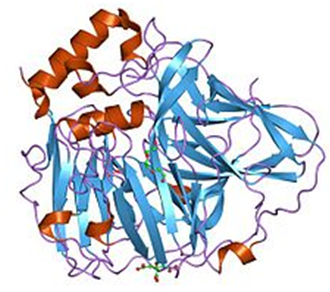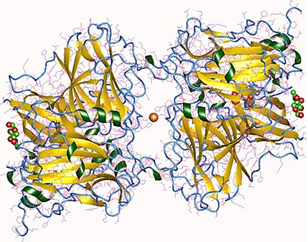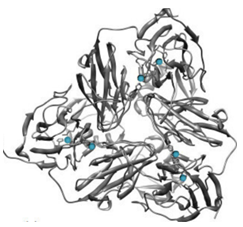Multi-Copper Oxidase Families
Multi-copper oxidases include ascorbate oxidase, laccase, plasma ceruloplasmin and other types. They are a very important class of metal oxidases in plants and play a pivotal role in various physiological processes in plants. Multicopper oxidases include ceruloplasmin, laccase, ascorbate oxidase and nitrite reductase.
 Figure 1. crystal structures of e. coli laccase cueo under different copper binding situations.
Figure 1. crystal structures of e. coli laccase cueo under different copper binding situations.
1. Ceruloplasmin
Ceruloplasmin is a copper-containing α2 glycoprotein with a molecular weight of about 120,000 to 160,000, which is not easy to purify. It is a single-chain polypeptide containing 6-7 copper atoms per molecule. It is blue due to copper and contains about 10% sugar. The terminal sialic acid is linked to the polypeptide chain and has genetic polymorphism. Its role is to regulate the distribution of copper in various parts of the body, to synthesize copper-containing enzyme proteins, it has the role of antioxidants, and has oxidase activity, and has the ability to catalyze the oxidation of polyphenols and polyamine substrates. It is generally believed that ceruloplasmin is synthesized by the liver, part of which is excreted by the biliary tract, and the urine content is very small. The determination of aeruginin has certain significance for the diagnosis of certain liver, gallbladder, kidney and other diseases.
Functions
The results of another study in recent years suggest that CERs act as antioxidants. The antioxidant activity of CER in the blood circulation can prevent the production of lipid peroxides and free radicals in tissues, which is of great significance especially in inflammation. CER is also an acute phase response protein. Plasma CER increases during infection, trauma, and tumor. Its most special effect is to assist the diagnosis of Wilson's disease, that is, the plasma CER content of the patient is significantly reduced, and the plasma dialysable copper content is increased. Most patients may have liver damage with neurological symptoms. If left untreated, the disease is progressive and fatal, so it should be diagnosed promptly and treated with copper chelator-penicillamine. Plasma CER also tends to decline during malnutrition, severe liver disease, and nephrotic syndrome. Women's content increased significantly during pregnancy and when taking oral contraceptives.
2. Laccase
Laccase is a polyphenol oxidase containing four copper ions. It belongs to the copper blue oxidase and exists as a monomer glycoprotein. Laccase exists in mushrooms, bacteria and plants, and can also survive in the air. The only product after the reaction is water, so it is essentially an environmentally friendly enzyme. The unique catalytic properties of laccase make it widely used in biological detection, and as an efficient biodetector, it becomes an effective tool and means for the analysis of components such as substrates, coenzymes and inhibitors. As environmental protection awareness has been gradually valued in recent years, laccase has become the research object of many scholars in recent years. Laccase is a copper protein, blue, with a molecular weight of about 120,000 and containing 4 atomic copper, which can be inhibited by CN-. Laccase can oxidize polyphenols, promote the methoxy substitution of phenol and diamine, and oxidize almost all substrates with similar structure of p-polyphenol. In addition, some fungal laccases can also oxidize monophenols such as cresol and ascorbic acid.
 Figure 2. L-ascorbate oxidase.
Figure 2. L-ascorbate oxidase.
3. Ascorbate oxidase
Ascorbate oxidase is a copper-containing enzyme that is located in the cytoplasm or combined with the cell wall and is coupled with other redox reactions to play the role of terminal oxidase. It can catalyze the oxidation of ascorbic acid and has anti-aging effects. Has an important role in the metabolism of substances. Under the catalysis of this enzyme, molecular oxygen can oxidize ascorbic acid to dehydroascorbic acid, which exists in the cytosol and cell wall, and the enzyme contains copper.
4. Nitrite reductase
Nitrite reductases (NiRs) are a class of enzymes that catalyze the reduction of nitrite. Most of the nitrite reductases are intracellular enzymes, which can effectively degrade nitrite in the cell. This enzyme is an oxidoreductase. The catalytic reaction process requires the participation of electron donors and transferors, and the reaction needs Under oxygen conditions. Nitrite reductase is widely present in microorganisms and plants and is a key enzyme in the nitrogen cycle of nature. It can degrade nitrite to NO or NH3, thereby reducing the accumulation of nitrite nitrogen in the environment and reducing the accumulation of nitrite resulting toxic effects on organisms.
 Figure 3. Protein structure of nitrite reductases.
Figure 3. Protein structure of nitrite reductases.
Reference
- Bento I.; et al. Dioxygen reduction by multi-copper oxidases; a structural perspective. Dalton Transactions. 2005, (21): 3507-13.